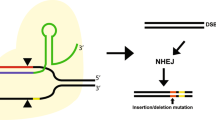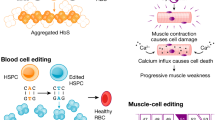Abstract
The capacity to correct a mutant gene within the context of the chromosome holds great promise as a therapy for inherited disorders but fulfilling this promise has proven to be challenging. However, steady progress is being made and the development of gene repair as a viable and robust approach is underway. Here, we present some of the recent advances that are helping to shape our thinking about the feasibility and the limitations of this technique. For the most part, these advances center on understanding the regulation of the reaction and validating its application in animal models.
This is a preview of subscription content, access via your institution
Access options
Subscribe to this journal
Receive 12 print issues and online access
$259.00 per year
only $21.58 per issue
Buy this article
- Purchase on Springer Link
- Instant access to full article PDF
Prices may be subject to local taxes which are calculated during checkout


Similar content being viewed by others
References
Thomas CE, Ehrhardt A, Kay MA . Progress and problems with the use of viral vectors for gene therapy. Nat Rev Genet 2003; 4: 346–358.
Liu L, Parekh-Olmedo H, Kmiec EB . The development and regulation of gene repair. Nat Rev Genet 2003; 4: 679–689.
Court DL, Sawitzke JA, Thomason LC . Genetic engineering using homologous recombination. Annu Rev Genet 2002; 36: 361–388.
Yu D, Sawitzke JA, Ellis H, Court DL . Recombineering with overlapping single-stranded DNA oligonucleotides: testing a recombination intermediate. Proc Natl Acad Sci USA 2003; 100: 7207–7212.
Drury MD, Kmiec EB . DNA pairing is an important step in the process of targeted nucleotide exchange. Nucleic Acids Res 2003; 31: 899–910.
Liu L, Cheng S, van Brabant AJ, Kmiec EB . Rad51p and Rad54p, but not Rad52p, elevate gene repair in Saccharomyces cerevisiae directed by modified single-stranded oligonucleotide vectors. Nucleic Acids Res 2002; 30: 2742–2750.
Igoucheva O, Alexeev V, Yoon K . Nuclear extracts promote gene correction and strand pairing of oligonucleotides to the homologous plasmid. Antisense Nucleic Acid Drug Dev 2002; 12: 235–246.
Thorpe P, Stevenson BJ, Porteous DJ . Optimising gene repair strategies in cell culture. Gene Therapy 2002; 9: 700–702.
Olsen PA, McKeen C, Krauss S . Branched oligonucleotides induce in vivo gene conversion of a mutated EGFP reporter. Gene Therapy 2003; 10: 1830–1840.
Ferrara L, Parekh-Olmedo H, Kmiec E . Enhanced oligonucleotide-directed gene targeting in mammalian cells following treatment with DNA damaging agents. Exp Cell Res 2004; 300: 170–179.
Ferrara L, Kmiec EB . Camptothecin enhances the frequency of oligonucleotide-directed gene repair in mammalian cells by inducing DNA damage and activating homologous recombination. Nucleic Acids Res 2004; 32: 5239–5248.
Suzuki T, Murai A, Muramatsu T . Low-dose bleomycin induces targeted gene repair frequency in cultured melan-c cells using chimeric RNA/DNA oligonucleotide transfection. Int J Mol Med 2003; 12: 109–114.
Holmes M et al. Gene correction therapy using designed zinc finger-based endonucleases. Mol Ther 2004; 9: S272.
Miller J et al. Structure-based engineering of the FokI DNA cleavage domain in the context of a chimeric endonuclease: towards maximally efficient ‘Gene Editing’ therapy. Mol Ther 2004; 9: S272.
Carroll D . Using nucleases to stimulate homologous recombination. Methods Mol Biol 2004; 262: 195–207.
Kaminski JM, Huber MR, Summers JB, Ward MB . Design of a nonviral vector for site-selective, efficient integration into the human genome. FASEB J 2002; 16: 1242–1247.
Kolb AF . Genome engineering using site-specific recombinases. Cloning Stem Cells 2002; 4: 65–80.
Olivares EC et al. Site-specific genomic integration produces therapeutic Factor IX levels in mice. Nat Biotechnol 2002; 20: 1124–1128.
Akopian A, He J, Boocock MR, Stark WM . Chimeric recombinases with designed DNA sequence recognition. Proc Natl Acad Sci USA 2003; 100: 8688–8691.
Andersen MS, Sorensen CB, Bolund L, Jensen TG . Mechanisms underlying targeted gene correction using chimeric RNA/DNA and single-stranded DNA oligonucleotides. J Mol Med 2002; 80: 770–781.
Dekker M, Brouwers C, Te RH . Targeted gene modification in mismatch-repair-deficient embryonic stem cells by single-stranded DNA oligonucleotides. Nucleic Acids Res 2003; 31: E27.
Alexeev V, Igoucheva O, Yoon K . Simultaneous targeted alteration of the tyrosinase and c-kit genes by single-stranded oligonucleotides. Gene Therapy 2002; 9: 1667–1675.
Thorpe PH, Stevenson BJ, Porteous DJ . Functional correction of episomal mutations with short DNA fragments and RNA–DNA oligonucleotides. J Gene Med 2002; 4: 195–204.
Hu Y et al. Reaction parameters of targeted gene repair in mammalian cells. Mol Biotech 2005; 29: 197–210.
Pierce EA et al. Oligonucleotide-directed single-base DNA alterations in mouse embryonic stem cells. Gene Therapy 2003; 10: 24–33.
Nickerson HD, Colledge WH . A comparison of gene repair strategies in cell culture using a lacZ reporter system. Gene Therapy 2003; 10: 1584–1591.
Kenner O et al. Targeted gene correction of hprt mutations by 45 base single-stranded oligonucleotides. Biochem Biophys Res Commun 2002; 299: 787–792.
Kenner O et al. Concurrent targeted exchange of three bases in mammalian hprt by oligonucleotides. Biochem Biophys Res Commun 2004; 321: 1017–1023.
Gruenert DC et al. Sequence-specific modification of genomic DNA by small DNA fragments. J Clin Invest 2003; 112: 637–641.
Lai LW, Lien YH . Therapeutic application of chimeric RNA/DNA oligonucleotide based gene therapy. Expert Opin Biol Ther 2001; 1: 41–47.
Lu IL et al. Correction/mutation of acid alpha-D-glucosidase gene by modified single-stranded oligonucleotides: in vitro and in vivo studies. Gene Therapy 2003; 10: 1910–1916.
Nakamura M et al. Targeted conversion of the transthyretin gene in vitro and in vivo. Gene Therapy 2004; 11: 838–846.
Nickerson HD, Colledge WH . A LacZ-based transgenic mouse for detection of somatic gene repair events in vivo. Gene Therapy 2004; 11: 1351–1357.
Igoucheva O, Alexeev V, Pryce M, Yoon K . Transcription affects formation and processing of intermediates in oligonucleotide-mediated gene alteration. Nucleic Acids Res 2003; 31: 2659–2670.
Brachman EE, Kmiec EB . DNA replication and transcription direct a DNA strand bias in the process of targeted gene repair in mammalian cells. J Cell Sci 2004; 117: 3867–3874.
Brachman EE, Kmiec E . Gene repair in mammalian cells is stimulated by the elongation of S phase and transient stalling of replication forks. DNA Repair 2005; 4: 445–457.
Igoucheva O, Alexeev V, Yoon K . Oligonucleotide-directed mutagenesis and targeted gene correction: a mechanistic point of view. Curr Mol Med 2004; 4: 445–463.
Brachman EE, Kmiec EB . Targeted gene repair of cyc1 mutations in Saccharomyces cerevisiae directed by modified single-stranded DNA oligonucleotides. Genetics 2003; 163: 527–538.
Radecke F, Radecke S, Schwarz K . Unmodified oligodeoxynucleotides require single-strandedness to induce targeted repair of a chromosomal EGFP gene. J Gene Med 2004; 6: 1257–1271.
Sorensen CB et al. Strand Bias in Gene Repair using Single-Stranded Oligonucleotides, abstract 1153. 6th Annual Meeting of the American Society of Gene Therapy: Washington, DC, 2003.
Parekh-Olmedo H, Engstrom J, Kmiec EB . The effect of hydroxyurea and trichostatin A on targeted nucleotide exchange in yeast and mammalian cells. Ann NY Acad Sci 2003; 1002: 43–56.
Majumdar A et al. Cell cycle modulation of gene targeting by a triple helix-forming oligonucleotide. J Biol Chem 2003; 278: 11072–11077.
Stojic L, Brun R, Jiricny J . Mismatch repair and DNA damage signalling. DNA Repair (Amst) 2004; 3: 1091–1101.
Brachman EE, Kmiec EB . The ‘biased’ evolution of targeted gene repair. Curr Opin Mol Ther 2002; 4: 171–176.
Li GM . DNA mismatch repair and cancer. Front Biosci 2003; 8: d997–d1017.
Saleh-Gohari N, Helleday T . Conservative homologous recombination preferentially repairs DNA double-strand breaks in the S phase of the cell cycle in human cells. Nucleic Acids Res 2004; 32: 3683–3688.
Zink D, Mayr C, Janz C, Wiesmuller L . Association of p53 and MSH2 with recombinative repair complexes during S phase. Oncogene 2002; 21: 4788–4800.
Brachman EE, Kmiec EB . DNA replication and transcription direct a DNA strand bias in the process of targeted gene repair in mammalian cells. J Cell Sci 2004; 117: 3867–3874.
Liu H, Agarwal S, Kmiec E, Davis BR . Targeted beta-globin gene conversion in human hematopoietic CD34(+) and Lin(−)CD38(−)cells. Gene Therapy 2002; 9: 118–126.
Osborn AJ, Elledge SJ, Zou L . Checking on the fork: the DNA-replication stress-response pathway. Trends Cell Biol 2002; 12: 509–516.
Shechter D, Costanzo V, Gautier J . Regulation of DNA replication by ATR: signaling in response to DNA intermediates. DNA Repair (Amst) 2004; 3: 901–908.
Olsen PA, Randol M, Krauss S . Implications of cell cycle progression on functional sequence correction by short single-stranded DNA oligonucleotides. Gene Therapy 2005 [E-pub ahead of print 27 January 2005; doi:10.1038/sj.gt.3302454].
Liu L, Usher M, Hu Y, Kmiec EB . Nuclease activity of Saccharomyces cerevisiae Mre11 functions in targeted nucleotide alteration. Appl Environ Microbiol 2003; 69: 6216–6224.
Bertoni C, Morris GE, Rando TA . Strand bias in oligonucleotide-mediated dystrophin gene editing. Hum Mol Genet 2005; 14: 221–233.
Bertoni C, Lau C, Rando TA . Restoration of dystrophin expression in mdx muscle cells by chimeraplast-mediated exon skipping. Hum Mol Genet 2003; 12: 1087–1099.
Igoucheva O, Yoon K . Gene targeting by oligonucleotides in keratinocytes. Methods Mol Biol 2004; 289: 287–302.
Acknowledgements
We are grateful to members of the community who communicated their unpublished results to us. We thank NIH and Tapestry Pharmaceuticals for continued financial support and we apologize to our colleagues whose work was not cited as primary references due only to space limitations. Hopefully, the cited reviews encompass their outstanding efforts.
Author information
Authors and Affiliations
Rights and permissions
About this article
Cite this article
Parekh-Olmedo, H., Ferrara, L., Brachman, E. et al. Gene therapy progress and prospects: targeted gene repair. Gene Ther 12, 639–646 (2005). https://doi.org/10.1038/sj.gt.3302511
Published:
Issue Date:
DOI: https://doi.org/10.1038/sj.gt.3302511
Keywords
This article is cited by
-
Analyses of point mutation repair and allelic heterogeneity generated by CRISPR/Cas9 and single-stranded DNA oligonucleotides
Scientific Reports (2016)
-
DNA Damage Response Pathway and Replication Fork Stress During Oligonucleotide Directed Gene Editing
Molecular Therapy - Nucleic Acids (2012)
-
Progress and prospects: oligonucleotide-directed gene modification in mouse embryonic stem cells: a route to therapeutic application
Gene Therapy (2011)
-
Simultaneous targeted exchange of two nucleotides by single-stranded oligonucleotides clusters within a region of about fourteen nucleotides
BMC Molecular Biology (2008)
-
Third strand-mediated psoralen-induced correction of the sickle cell mutation on a plasmid transfected into COS-7 cells
Gene Therapy (2007)



